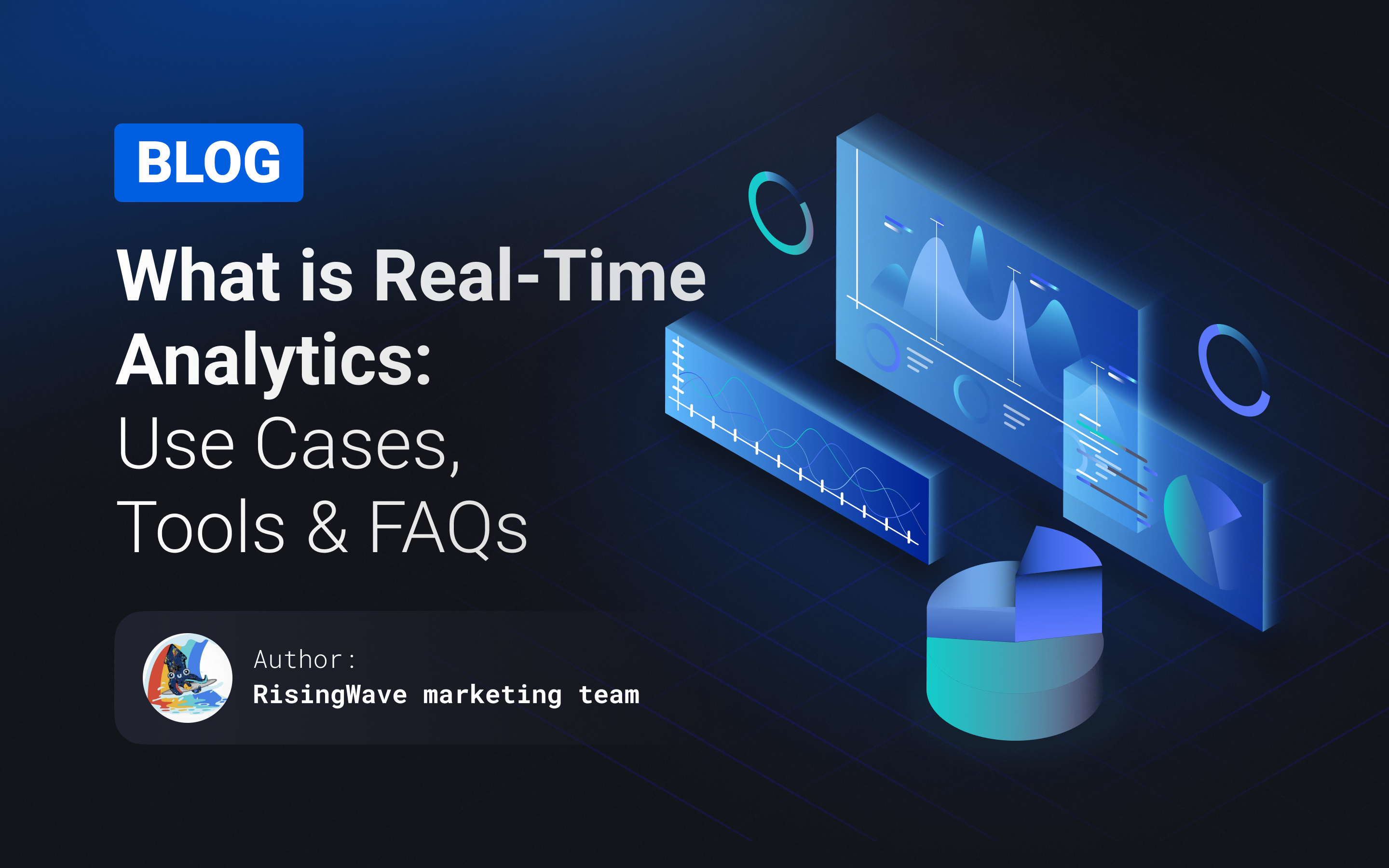In today's rapidly evolving digital landscape, the expectation of application users to analyze data in real-time is skyrocketing. Users demand immediate insights without leaving their application, waiting for analytics to load, or making decisions based on stale data that's minutes or hours old.
Historically, developing real-time analytics has been challenging, time-consuming, and costly, limited to a few time-sensitive use cases. However, technological advancements have now made real-time analytics accessible to even the most resource-constrained engineering teams.
In this guide to real-time analytics, we will take you on a journey through the fundamentals of real-time analytics - from understanding what it is and how it works to exploring its numerous benefits. Get ready to explore real-world applications of real-time analytics in quantitative investment, travel industry, personalized news feed, and more. We will also unveil the top 5 tools that can supercharge your real-time analytics capability and answer some of the frequently asked questions, such as how real-time analytics differs from batch analytics.
What is Real-Time Analytics?
Real-time analytics is the process of analyzing data the moment it becomes available, enabling immediate insights and decision-making. This cutting-edge approach contrasts sharply with traditional batch-style analytics, which might take hours or days to process, offering insights only after events have occurred. Real-time analytics empowers businesses to act swiftly, capitalizing on opportunities or averting potential issues as they arise, rather than relying solely on historical data which provides insights after the fact.
The effectiveness of real-time analytics hinges on two critical latency aspects: data latency and query latency. Data latency refers to the delay between data generation and its availability for querying, which real-time systems strive to minimize. Conversely, query latency is the time it takes to execute a query and obtain results, with a focus on reducing it to ensure responsive user experiences. Achieving low data and query latencies requires systems that can concurrently handle high data input rates and allow for quick querying of the latest data, a challenge that traditional batch analytics systems are not designed to meet.
Benefits of Real-Time Analytics
In the fast-paced business environment of today, leveraging real-time analytics can offer substantial advantages. Below are the key benefits these tools provide:
- Enhanced Customer Insight: By accessing up-to-the-minute customer data, businesses can tailor responses swiftly. Real-time analytics shed light on customer behaviors—identifying the when, why, and how to enhance customer satisfaction.
- Cost Reduction and Profitability: Real-time analytics drive cost savings across various organizational aspects, including hiring, retention, and employee engagement, while also alleviating the burden on IT departments. This contributes to improved profitability and provides a competitive edge.
- Agility in Response: The ability to quickly adapt to market changes can unlock significant opportunities. Real-time analytics equip businesses to preemptively address potential challenges or capitalize on lucrative prospects, ensuring a proactive stance in a dynamic market.
- Data-Driven Decision Making: Access to instant data allows companies to predict trends with greater accuracy and refine their strategies. This enables effective real-time testing, such as A/B testing, facilitating clearer decision-making processes and optimizing outcomes.
Real-Time Analytics Use Cases
Real-time analytics finds application in various industries, providing value and actionable insights in different use cases. In this section, we will explore two common use cases of real-time analytics, highlighting their benefits and real-world examples.
Use of Real-Time Analytics in travel industry
In the travel industry, the application of real-time analytics transforms how businesses operate and interact with their customers. This dynamic approach enables companies to adjust pricing strategies swiftly in response to demand fluctuations, enhancing revenue generation and ensuring competitive pricing. Instant analysis of customer behavior supports the creation of personalized marketing campaigns that drive engagement and foster loyalty, tailoring offers and experiences to meet the evolving needs and preferences of travelers.
Furthermore, predicting travel trends becomes more accurate and actionable with access to real-time data, empowering businesses to make agile decisions that align with market dynamics. This agility is crucial for the efficient management of inventory and resources, allowing companies to optimize allocation and reduce waste. The strategic application of real-time analytics in the travel industry not only streamlines operations but also significantly improves the customer experience by offering more relevant, timely, and cost-effective travel options.
Use of Real-Time Analytics in quantitative investment
Use of Real-Time Analytics in Quantitative Investment In the fast-paced world of quantitative investment, real-time analytics is a game-changer. It enables investors to instantly identify market trends, monitor portfolio risks, and execute trades with precision. This rapid analysis is key to capturing fleeting opportunities and managing risks on the fly, providing a significant edge in the competitive financial markets. For example, Zhuoshi Fund harnesses cutting-edge machine learning technologies and a low-latency trading system to thrive on real-time insights, demonstrating the vital role of real-time analytics in staying ahead.
Web Analytics for Product Builders
For product builders, web analytics powered by real-time data offer immediate insights into user behavior on websites. Tracking interactions, click-through rates, and conversions in real-time enables quick adjustments to website design and marketing strategies. Real-time analytics tools present dashboards with live updates for continuous monitoring of website performance, empowering product builders to optimize user experience and enhance engagement.
Top 5 Real-Time Analytics Tools
Apache Kafka
Apache Kafka, a distributed event streaming platform, boasts high throughput and fault tolerance, enabling real-time processing for quick data stream reactions. Widely used for log aggregation and stream processing, it offers scalability and durability to handle large data volumes instantly. With low latency architecture, Apache Kafka is ideal for real-time analytics applications, ensuring efficient data processing for informed decision-making in various industries.
Apache Flink
Apache Flink, known for its high throughput and fault tolerance, excels in real-time data processing. Its event time processing efficiently manages out-of-order events. With versatile APIs, Flink suits various real-time analytics applications. Stateful computations support complex tasks seamlessly. The robust ecosystem provides connectors for seamless integration with popular data sources.
RisingWave
RisingWave is a distributed SQL streaming database that enables simple, efficient, and reliable processing of streaming data. It stands out in two primary dimensions: Ease-of-use and cost efficiency, thanks to its PostgreSQL-style interaction experience and Snowflake-like architectural design.
RisingWave significantly reduces the complexity of building stream-processing applications by allowing developers to express intricate stream-processing logic through cascaded materialized views. Furthermore, it allows users to persist data directly within the system, eliminating the need to deliver results to external databases for storage and query serving.
Spark Streaming
Spark Streaming, a robust tool for real-time analytics, efficiently processes data streams. Integrated within the Apache Spark ecosystem, it ensures scalable and fault-tolerant stream processing. Utilizing micro-batching, it achieves near real-time data processing with minimal latency. By incorporating fault recovery and checkpointing mechanisms, it guarantees the reliability of data. Spark Streaming is particularly beneficial for scenarios necessitating continuous data processing and swift insights delivery.
Google Cloud Dataflow
Google Cloud Dataflow efficiently processes data for insights and analytics, offering scalability for large datasets. Building data pipelines is seamless with its programming model, seamlessly integrating with other Google Cloud services. Dataflow ensures reliable real-time data processing for diverse applications, enhancing decision-making with accurate insights. The tool's ability to handle large datasets and integrate with Google Cloud services sets it apart in the realm of data analytics solutions.
FAQs
Real-Time vs. Batch Analytics
Real-time analytics offer immediate insights, enabling quick decision-making based on up-to-the-minute information. In contrast, batch analytics process data in intervals, ideal for historical trend analysis. While real-time provides instant data, batch analytics are more cost-effective for processing large volumes of data at once. Both methods have their place depending on business needs, balancing the immediacy of real-time analytics with the efficiency of batch processing.
Real-Time Analytics and Streaming Analytics
Real-time analytics prioritizes immediate data processing within strict time limits to support instant decision-making, whereas streaming analytics focuses on managing continuous data flows from various sources. The key distinction is that real-time analytics is defined by its response time requirements, while streaming analytics is characterized by its approach to handling unending data streams. Essentially, real-time analytics demands fast data processing speeds, whereas streaming analytics involves the continuous ingestion and processing of data, regardless of the processing speed.
What Is a Streaming Database?
A streaming database is a type of database that is designed specifically to process large amounts of real-time streaming data. Unlike traditional databases, which store data in batches before processing, a streaming database processes data as soon as it is generated, allowing for real-time insights and analysis. Unlike traditional stream processing engines that do not persist data, a streaming database can store data and respond to user data access requests. Streaming databases are ideal for latency-critical applications such as real-time analytics, fraud detection, network monitoring, and the Internet of Things (IoT) and can simplify the technology stack.
RisingWave vs Apache Flink
Both RisingWave and Apache Flink are designed for building real-time stream processing applications. But they differ drastically in design, user experiences, and cost efficiency.
Specifically, RisingWave enables users to manage and process stream data using a PostgreSQL-like approach, performing continuous real-time stream processing, in addition to offering data storage and ad-hoc query access. Built from scratch using Rust, RisingWave adopts a decoupled compute-storage architecture to optimize for high-throughput and low-latency stream processing in the cloud.
Flink features a distributed dataflow engine that supports parallel, pipelined, and iterative execution of data processing programs. Initially inspired by the classic MapReduce paradigm, Flink exposes its lower-level APIs in different programming languages and offers a SQL wrapper for users to craft and manage computing jobs.
In this blog, we explored how real-time analytics enhances customer experiences, improves operational efficiency, and provides a competitive advantage across industries. Among the tools facilitating this transformation, RisingWave emerges as a powerful option for organizations seeking to adopt real-time analytics. Sign up for our monthly newsletter if you’d like to keep up to date on all the happenings with RisingWave. Follow us on Twitter and LinkedIn, and join our Slack community to talk to our engineers and hundreds of streaming enthusiasts worldwide.






